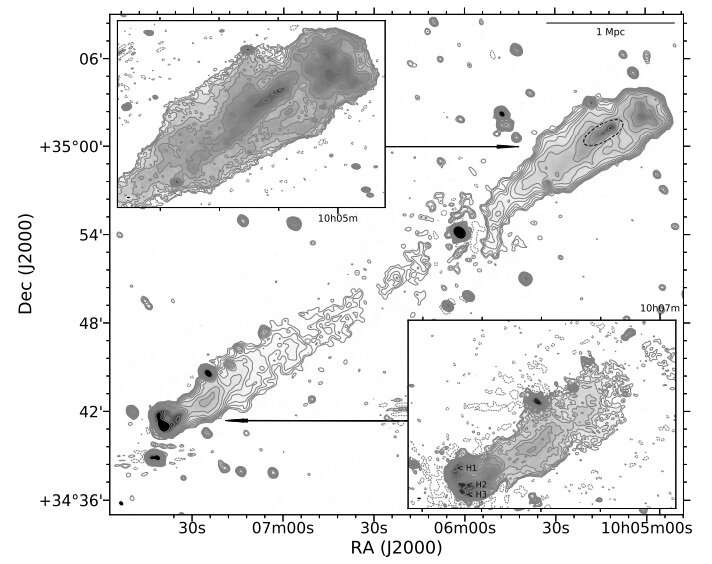July 29, 2019 report
Radio galaxy 3C 236 investigated with LOFAR

Using the LOw Frequency ARray (LOFAR) astronomers took a closer look at the giant radio galaxy 3C 236. The observations, detailed in a paper published July 22 on the arXiv pre-print repository, shed more light on the morphology and structure of 3C 236, which could be helpful in advancing our knowledge about radio galaxies in general.
Radio galaxies emit huge amounts of radio waves from their central cores. Black holes at the centers of these galaxies accrete gas and dust, generating high-energy jets visible in radio wavelengths, which accelerate electrically charged particles to high velocities.
Giant radio galaxies (GRGs) are distinguished by radio-emitting regions like jets or lobes extending over projected distances of at least 3 million light years. With radio lobes reaching about 14.7 million light years, 3C 236 is one of the largest GRGs known to date. Although many studies of 3C 236 have been conducted since its discovery in late 1950s, still many questions about radio emission from this source remain unanswered.
Instruments like LOFAR could be crucial for resolving such uncertainties. This array allows studies of extended GRG morphology in a comprehensive manner at very low frequencies. As a result, such observations could disclose details regarding energetics and activity history of radio sources.
In October 2018, a team of astronomers led by Alexandar Shulevski of University of Amsterdam, the Netherlands, decided to employ LOFAR to investigate 3C 236. The main aim of these observations was to perform high-resolution mapping of the radio morphology of the galaxy's extended structure at the lowest frequencies to date. By doing this, they hoped to trace the oldest emission regions in 3C 236.
"We have examined the giant radio galaxy 3C 236 using LOFAR at 143 MHz down to an angular resolution of 7'', in combination with observations at higher frequencies. We have used the low frequency data to derive spectral index maps with the highest resolution yet at these low frequencies," the astronomers wrote in the paper.
The new observations identified an inner hotspot in the northwest lobe of 3C 236. Its presence was, in fact, detected by previous studies. However, this hotspot was found to be separated from its more diffuse outer region and has experienced more recent particle acceleration. This, according to the researchers, may indicate a short interruption of the accretion episode.
Moreover, the study found that other region—the southeast lobe double hotspot—turned to be a triple hotspot. The observations have shown that hotspot's brighter component actually consists of two components, making it three overall.
In concluding remarks, the astronomers reveal what could be responsible for the observed morphology of the lobes in 3C 236. They assume that the confinement by the intergalactic medium (IGM) is the most plausible scenario.
"The source energy/pressure balance with the IGM suggests that confinement by the IGM may be responsible for the morphology of the lobes; the NW lobe is probably confined and the SE one has expanded in a lower density medium, reflected in the somewhat steeper spectrum of its outer region/northern edge," the authors of the paper wrote.
They added that their research is a great example proving the usefulness of LOFAR in studying GRGs and other radio sources. The instrument has the potential to unveil previously unknown features even in objects that have been studied for decades, as was in the case with 3C 236.
More information: LOFAR first look at the giant radio galaxy 3C 236, arXiv:1907.09060. arxiv.org/pdf/1907.09060.pdf
© 2019 Science X Network





















